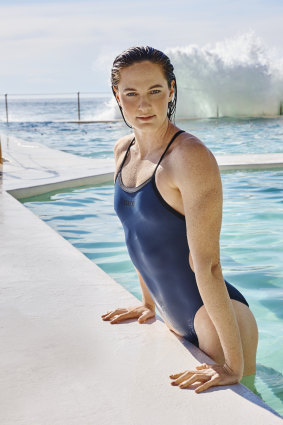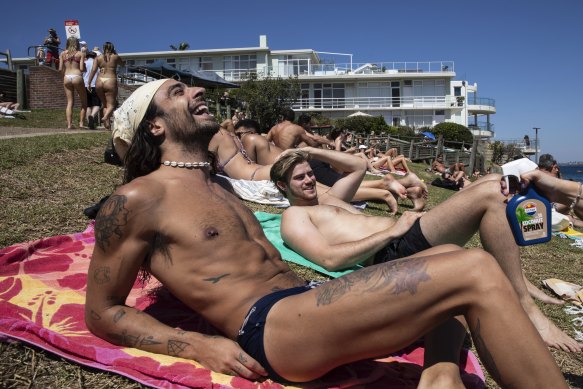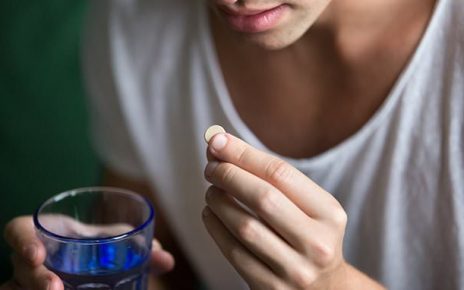Save articles for later
Add articles to your saved list and come back to them any time.
Our bodies get a lot from the sun. It helps set our body clock, offers protection from depression, anxiety and other mental health issues, and helps us synthesise vitamin D, which supports our bones, hormone function and immune system.
We need sunlight and yet we live in a country where rates of skin cancer are the highest in the world by far says Professor Anne Cust, chair of Cancer Council’s National Skin Cancer Committee.
Scarred from her experience with melanoma: Olympic swimmer Cate Campbell.
Nearly 20,000 Australians were diagnosed with skin cancer in 2022, more than 1000 died from it and treating it costs us about $1.5 billion annually.
Four-time Olympian Cate Campbell was just 26 when she was diagnosed with melanoma, the most serious type of skin cancer.
“I have inherited a pale, freckly complexion thanks to Scottish heritage, which is great in Scotland but not so good in Australia,” says the 31-year-old, who is an Avene Suncare ambassador.
Though Campbell never actively tanned, she admits she had her fair share of sunburns as a child, which can double the risk for melanoma. After bumping into an old friend, who explained a large scar on his arm was the result of having a melanoma removed, Campbell booked a skin check.
Two days after the check, her dermatologist phoned with news that a mole on her right upper arm was melanoma. One day later, she was in surgery having it removed. Thankfully, they had caught it at stage 1, which has a 98 per cent survival rate, compared to a 20 per cent survival rate by stage 4.
“I was left reeling from the experience,” the Brisbane-based swimmer admits. “I wonder what would have happened if I hadn’t caught up with my friend or didn’t put getting a skin check straight to the top of my priority list?”
Now, fully recovered, Campbell applies sunscreen daily, whether she is planning to be in the sun or not. And she’s not alone.
A timely skin check identified Campbell’s cancer.
The paradox of sunscreen use
Australians are using sunscreen more than ever before, yet rates of melanoma continue to rise. At the same time, nearly one in four of us have vitamin D deficiency. So, what is going on?
This complicated situation is what the Canadian authors of a new paper refer to as the “paradox of sunscreen use”. They attribute it, in part, to the false sense of security applying sunscreen gives people. For instance, they either don’t apply enough, don’t reapply every two hours, don’t use other forms of sun protection (like hats, protective clothing and share) or use sunscreen as a “permission slip” to tan.
“Some people think they’re invincible if they’ve applied it, but they’re not,” says the Cancer Council’s Cust.
While the incidence of melanoma may be rising, it is typically among those over 40. As more children who use sun protection grow up, melanoma incidence will start to fall, says Professor Rachel Neale, group leader in cancer aetiology and prevention at the QIMR Berghofer Medical Research Institute in Brisbane.
Ingredient concerns for consumers
Both Cust and Neale stress that the sunscreen paradox does not suggest that sunscreen use increases the risk of skin cancer. Quality evidence has found time and time again that sunscreen does protect us from skin cancer – but it’s a fact complicated by another fact: people who tend to apply sunscreen also tend to have higher risk factors for skin cancer, including very fair skin.
In 2022, the Therapeutic Goods Administration recalled a number of sunscreens after low levels of a carcinogen chemical, benzene, was detected. Similar recalls have occurred in the United States.
These events don’t help consumer confidence. Previous research by the Cancer Council has found only about half of Australians adults think it is safe to use sunscreen daily and 17 per cent worry that sunscreens contain ingredients that may do more harm than good.
Harm unlikely
To get gold standard evidence for the cumulative effects of lifelong sunscreen use, researchers would need to randomly assign one group of children to daily sunscreen for 40 years and compare them with a group that does not.
“Clearly we can’t do a study like that,” Neale says. “Therefore I think we have to be somewhat reliant on the results of laboratory tests on animals and cells.”
Evidence suggests that some chemical ingredients may be absorbed into our bodies but are unlikely to be harmful. Studies on lab animals showing harm, Neale adds, have been done using “massive, massive high concentrations”.
Experts say some Australians use sunscreen as a “permission slip” to tan.Credit: Jessica Hromas
There are sunscreens, including titanium dioxide and zinc oxide-based physical creams, which don’t contain the ingredients that concern some people. But, based on the evidence she has looked at, Neale feels safe to apply sunscreen daily and advises her daughters to as well.
Cust agrees that the levels of ingredients in TGA-approved sunscreens are safe. “They are very strictly monitored.”
Vitamin D absorption and sunscreen
As for the vitamin D piece of the puzzle, it’s a little more complex.
“The amount of vitamin D that you make by spending time in the sun varies according to your skin type, where you live geographically, the season and the time of day,” Cust explains.
Though 20 per cent of Australians believe that using sunscreen regularly might inhibit vitamin D, two randomised controlled trials found that sunscreen users had equivalent levels of vitamin D to non-sunscreen users.
Still, the daily sunscreen users in each group applied the relatively low SPF 16. Neale has just completed a randomised controlled trial of people around Australia using SPF 50 daily compared with people who do not. She expects those results in about six months.
Meanwhile, she led a group that published an updated set of sun exposure guidelines earlier this year, based on the knowledge that sunlight plays a vital role in our health – and that “completely avoiding sun exposure is not optimal for health”.
For the first time, the nuanced guidelines state that dark-skinned people, who have a much higher risk of vitamin D deficiency and a much lower risk of ultra violet-induced skin cancer, do not need to apply sunscreen unless they will be outside on a high UV day for a prolonged period.
For everyone else, time in sunlight recommendations for adequate vitamin D levels are given based on the time of day, time of year and your location in Australia – which means, typically, no more than five to 10 minutes between 9 and 5pm during warmer months.
They also advise using sunscreen daily on all days when the UV index is forecast to reach three, which is most days in most months except winter in some parts of the country.
Make the most of your health, relationships, fitness and nutrition with our Live Well newsletter. Get it in your inbox every Monday.
Most Viewed in Lifestyle
From our partners
Source: Read Full Article






